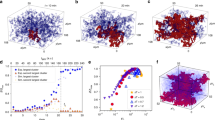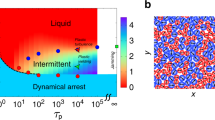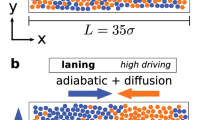Abstract
A wide variety of systems, including granular media, colloidal suspensions and molecular systems, exhibit non-equilibrium transitions from a fluid-like to a solid-like state, characterized solely by the sudden arrest of their dynamics. Crowding or jamming of the constituent particles traps them kinetically, precluding further exploration of the phase space1. The disordered fluid-like structure remains essentially unchanged at the transition. The jammed solid can be refluidized by thermalization, through temperature or vibration, or by an applied stress. The generality of the jamming transition led to the proposal2 of a unifying description, based on a jamming phase diagram. It was further postulated that attractive interactions might have the same effect in jamming the system as a confining pressure, and thus could be incorporated into the generalized description. Here we study experimentally the fluid-to-solid transition of weakly attractive colloidal particles, which undergo markedly similar gelation behaviour with increasing concentration and decreasing thermalization or stress. Our results support the concept of a jamming phase diagram for attractive colloidal particles, providing a unifying link between the glass transition3, gelation4,5 and aggregation6,7,8.
This is a preview of subscription content, access via your institution
Access options
Subscribe to this journal
Receive 51 print issues and online access
$199.00 per year
only $3.90 per issue
Buy this article
- Purchase on Springer Link
- Instant access to full article PDF
Prices may be subject to local taxes which are calculated during checkout




Similar content being viewed by others
References
Edwards, S. F. & Grinev, D. V. in Jamming and Rheology: Constrained Dynamics on Microscopic and Macroscopic Scales (eds Liu, A. J. & Nagel, S. R.) 80–93 (Taylor and Francis, New York, 2001).
Liu, A. J. & Nagel, S. R. Jamming is not just cool anymore. Nature 396, 21–22 (1998).
Pusey, P. N. & van Megen, W. Observation of a glass transition in suspensions of spherical colloidal particles. Phys. Rev. Lett. 59, 2083–2086 (1987).
Grant, M. C. & Russel, W. B. Volume-fraction dependence of elastic moduli and transition temperatures for colloidal silica gels. Phys. Rev. E 47, 2606–2614 (1993).
de Rooij, R., van den Ende, D., Duits, M. H. G. & Mellema, J. Elasticity of weakly aggregating polystyrene latex dispersions. Phys. Rev. E 49, 3038–3049 (1994).
Weitz, D. A. & Oliveria, M. Fractal structures formed by kinetic aggregation of aqueous gold colloids. Phys. Rev. Lett. 52, 1432–1435 (1984).
Carpineti, M. & Giglio, M. Spinodal-type dynamics in fractal aggregation of colloidal clusters. Phys. Rev. Lett. 68, 3327–3330 (1992).
Gisler, T. & Weitz, D. A. Strain hardening of fractal colloidal gels. Phys. Rev. Lett. 82, 1064–1067 (1999).
Cates, M. E., Wittmer, J. P., Bouchaud, J. P. & Claudin, P. Jamming, force chains, and fragile matter. Phys. Rev. Lett. 81, 1841–1844 (1998).
Trappe, V. & Weitz, D. A. Scaling of the viscoelasticity of weakly attracting particles. Phys. Rev. Lett. 85, 449–452 (2000).
Segre, P. N., Prasad, V., Schofield, A. B. & Weitz, D. A. Glass-like kinetic arrest at the colloidal gelation transition. Phys. Rev. Lett. (in the press).
Pusey, P. N. & van Megen, W. Phase behaviour of concentrated suspensions of nearly hard colloidal spheres. Nature 320, 340–342 (1986).
O'Hern, C. J., Langer, S. A., Liu, A. J. & Nagel, S. R. Force distributions near jamming and glass transitions. Phys. Rev. Lett. 86, 111–114 (2001).
Pusey, P. N., Pirie, A. D. & Poon, W. C. K. Dynamics of colloid polymer mixtures. Physica A 202, 322–327 (1993).
Melrose, J. R. & Ball, R. C. The pathological behaviour of sheared hard spheres with hydrodynamic interactions. Europhys. Lett. 32, 535–540 (1995).
Acknowledgements
We thank S. Nagel and A. Liu for valuable discussions, and for permission to reproduce Fig. 1. This work was supported by Infineum, the NSF and NASA.
Author information
Authors and Affiliations
Corresponding author
Rights and permissions
About this article
Cite this article
Trappe, V., Prasad, V., Cipelletti, L. et al. Jamming phase diagram for attractive particles. Nature 411, 772–775 (2001). https://doi.org/10.1038/35081021
Received:
Accepted:
Issue Date:
DOI: https://doi.org/10.1038/35081021
This article is cited by
-
Complex optical transport, dynamics, and rheology of intermediately attractive emulsions
Scientific Reports (2023)
-
The hidden hierarchical nature of soft particulate gels
Nature Physics (2023)
-
Patterning and dynamics of membrane adhesion under hydraulic stress
Nature Communications (2023)
-
Agglomeration: when folded proteins clump together
Biophysical Reviews (2023)
-
Effects of force chain on the jamming during iron powder compaction
Computational Particle Mechanics (2023)
Comments
By submitting a comment you agree to abide by our Terms and Community Guidelines. If you find something abusive or that does not comply with our terms or guidelines please flag it as inappropriate.



